
Royal Botanic Gardens, Kew is a non-departmental public body in the United Kingdom sponsored by the Department for Environment, Food and Rural Affairs. An internationally important botanical research and education institution, it employs 1,100 staff. Its board of trustees is chaired by Dame Amelia Fawcett.

Salix caprea, known as goat willow, pussy willow or great sallow, is a common species of willow native to Europe and western and central Asia.
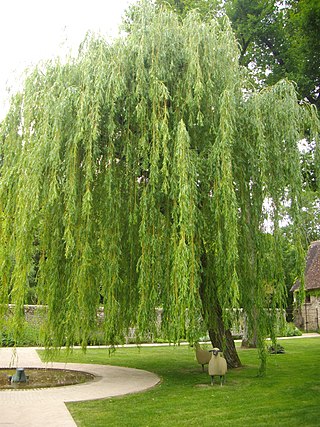
Salix babylonica is a species of willow native to dry areas of northern China, Korea, Mongolia, Japan, and Siberia but cultivated for millennia elsewhere in Asia, being traded along the Silk Road to southwest Asia and Europe.
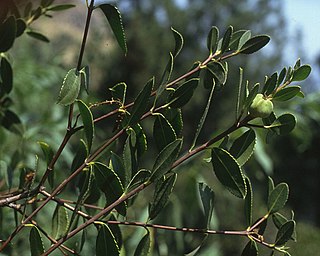
Colliguaja is a plant genus of the family Euphorbiaceae first described as a genus in 1782. It is native to South America.
- Colliguaja brasillensisKlotzsch ex Baill. - Paraguay, S Brazil, Uruguay
- Colliguaja dombeyanaA.Juss. - S Chile
- Colliguaja integerrimaGillies & Hook. - S Chile, W Argentina
- Colliguaja odoriferaMolina - N & C Chile
- Colliguaja salicifoliaGillies & Hook. - C Chile

Jubaea is a genus of palms with one species, Jubaea chilensis, commonly known in English as the Chilean wine palm or Chile cocopalm, and palma chilena in Spanish. It is native to southwestern South America and is endemic to a small area of central Chile between 32°S and 35°S in southern Coquimbo, Valparaíso, Santiago, O'Higgins, and northern Maule regions.
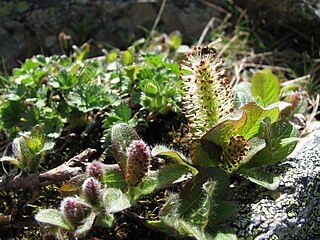
Salix nakamurana is a rare species of willow native to alpine slopes of central Japan. It is a deciduous small prostrate shrub.

Salix myrsinifolia, known as the dark-leaved willow or myrsine-leaved willow, is a species of willow native to Europe and Western Siberia. It forms a 2–5 m (6.6–16.4 ft) high shrub. In the north it often becomes a tree up to 8 m (26 ft) tall.
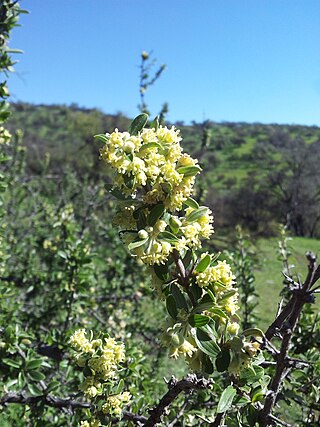
Trevoa is a genus of actinorhizal plants; these dicotyledon flora are trees or small shrubs. The genus was first proposed by Miers in 1825, but was not fully described until 1830 by Sir William Jackson Hooker. Genus members are notable for their ability to fix nitrogen. Species of this genus are generally found in the near coastal forests and arid shrubland of South America. Some species are localized in the mountains of central Chile; for example, the species Trevoa trinervis occurs in the La Campana National Park and other proximate areas of central Chile.

Salix glaucosericea, common name silky willow or Alpine grey willow, is a species of flowering plant in the Salicaceae family. Some authorities consider it a synonym of Salix glauca var. villosa, which is found in western North America.

Salix humboldtiana, called Humboldt's willow, is a tree species of willow native to North and South America, growing along watercourses. Some authorities consider it a synonym of Salix chilensis, which Molina described in 1782. Willdenow described Salix humboldtiana in 1805.

Salix mesnyi is a species of willow native to southern and eastern China, Taiwan, and Vietnam. It can be found among shrubs near water growing 15 metres (49 ft) tall.

Salix acmophylla, also known as brook willow, is a willow native to central Asia, the Middle East and Egypt.

Salix irrorata, the dewystem willow, blue-stem willow, or sandbar willow, is a species of willow native to the US states of Wyoming, Colorado, Arizona, and New Mexico, and to northern Mexico. In spite of its bluestem willow common name, its stems are red, but a white coat develops that makes them appear bluish. A bushy shrub that prefers moist areas, in a garden setting it needs coppicing to both keep it from growing overlarge and to maintain the attractive bark coloration. It has gained the Royal Horticultural Society's Award of Garden Merit as an ornamental.
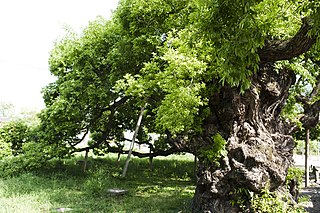
Salix pierotii, the Korean willow, is a species of willow native to northeast China, far eastern Russia, the Korean peninsula and Japan. They are shrubs or trees reaching 8 m. Because their twisted wood is not good for timber or making tools, in Japan Salix pierotii trees are used to demarcate property lines between farms.
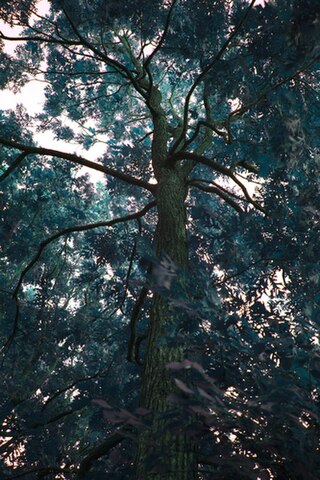
Quercus × bebbiana, known as Bebb's oak, is a naturally occurring hybrid of white oak and burr oak. It occurs where their ranges overlap in the eastern United States and eastern Canada. It was named for Michael Schuck Bebb (1833–1895), an Illinois botanist who specialized in willows (Salix). Its parents are both placed in Quercus sect. Quercus.
Salix caspica is a plant from the willow genus (Salix) within the willow family (Salicaceae). The natural range extends from eastern European Russia to far western China.

Libertia chilensis, synonym Libertia formosa, called the New Zealand satin flower, snowy mermaid, or Chilean-iris, is a species of flowering plant in the iris family, Iridaceae, native to the Juan Fernández Islands, central and southern Chile, and southern Argentina. It can also be found growing wild in the San Francisco Bay Area and San Bernardino County in California, where it is an introduced species. A rhizomatous evergreen perennial, it has gained the Royal Horticultural Society's Award of Garden Merit.

Salix lindleyana, the creeping Himalayan willow, is a species of willow in the family Salicaceae, found in the Himalayas, from northeast Pakistan to Yunnan in China.

Stephen Conrad Stuntz (1875–1918) was an American botanist and fiction author.
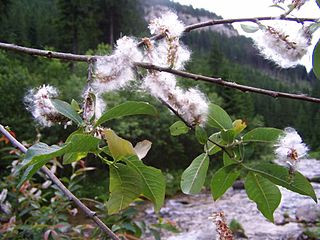
Salix silesiaca, the Silesian willow, is a species of flowering plant in the family Salicaceae. It is native to the Sudeten and Carpathian Mountains, and the mountains of the Balkan Peninsula. A shrub reaching 6 ft (2 m), it is considered to be a member of the informal sallow group.



















